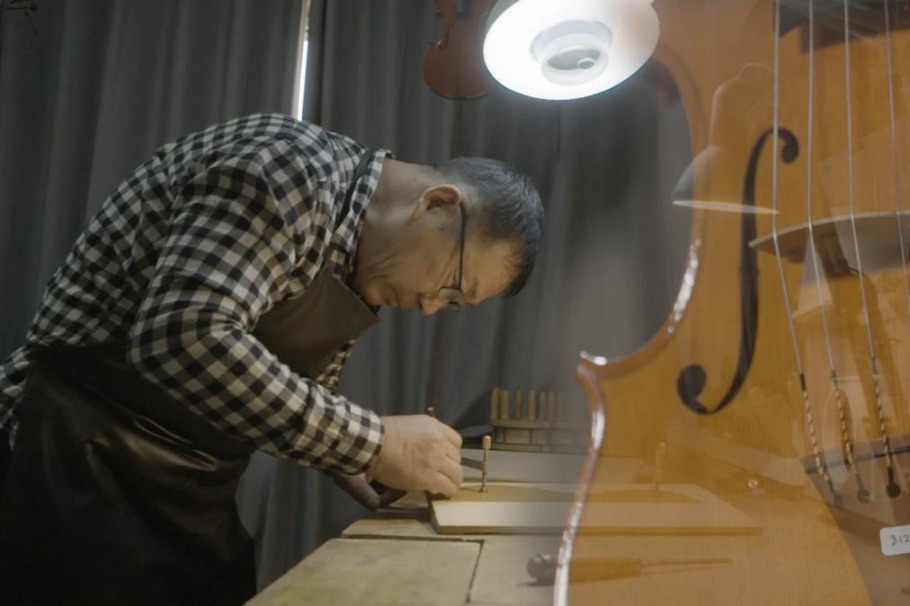A stitch in time keeps qipao tradition alive


JINAN-Zhang Jin's day usually begins with the gentle clicks of a treadle sewing machine. The time slips by quickly as he sews tailor-made qipao for customers across the country.
The qipao, a traditional dress, has long been popular as a fashion icon of Chinese elegance.
In 1987, at the age of 15, Zhang started learning garment-making from the descendants of the Hongbang tailors.
The tailors, originally from Ningbo, Zhejiang province, were renowned in the early 20th century for their skills at sewing Chinese tunic dresses and Western-style suits.
They are also thought to have fashioned the first Chinese tunic suit, also known as the Zhongshan suit, after statesman Sun Yat-sen (1866-1925), who ended imperial rule in China.
"We followed conventional rules at that time," Zhang said of his training. "As an apprentice, I was in charge of all chores, including cooking, cleaning and doing the laundry. Only if you did those for two years would you be allowed to learn clothes-making skills."
During his first three months, Zhang had to learn how to make buttonholes and the correct use of a thimble, as well as ironing and hemming clothes every day.
Once he had a good grasp of the basic skills, Zhang stepped up to making pants.
"At the beginning, I could make only three pairs of pants a day, then five, 10, and 20 pairs a day," he said.
Finally, Zhang was allowed to learn how to make a qipao, which is known for the complexity and multiple procedures involved in making it.
After completing three years of training, Zhang opened a garment shop in Jinan, capital of Shandong province.
Weak demand
However, the mechanization of the garment-making industry in the 1990s brought low prices and a wide range of styles in polyester materials, which resulted in a fall off in demand for handmade clothes.
Zhang's shop was hit hard. He had to turn to other business, including selling flowers and running restaurants.
In 2001, traditional Chinese garments regained their popularity after the Asia-Pacific Economic Cooperation Forum meeting in Shanghai, at which leaders from many countries wore traditional Tang suits.
Seizing the opportunity, Zhang returned to the garment industry in 2006. "Every family wants to wear traditional clothes during the Spring Festival, and more and more people are starting to wear the qipao," he said.
The qipao originated from gowns worn by women in the Qing Dynasty (1644-1911). Influenced by Western culture, the qipao changed repeatedly during the early 20th century, becoming more fitted and body-hugging, with side slits that reached up to the thigh. During the 1930s and 1940s, it gradually evolved into its current form.
Unlike qipao dresses from the assembly line, Zhang tailors the garments on the basis of the customer's figure. He takes more than 20 measurements to ensure the uniqueness of every dress, and uses different fabrics and designs to suit each person's body shape and different occasions.
"Each qipao is a one-of-a-kind product," Zhang said.
While electric sewing machines are now common, they cannot replace manual skills, he said, so Zhang combines hand stitching and the use of nonelectric machines.
"A qipao must go through dozens of processes, from measuring to forming," said Zhang, adding that just a narrow piece of edging needs to go through nearly 10 procedures, taking three to four days to complete.
Modern take
Zhang has adjusted his designs to keep pace with changing tastes. The modern qipao has a zipper stitched into the side and a fake fastener on the front.
Traditionally, the front was fastened by pankou knots, but these are now only used for decoration, which saves time when putting on the garment.
In Zhang's view, the qipao is not just a simple dress that covers people's bodies, but a garment that embodies traditional Chinese etiquette and culture.
With collars that stick upward rather than folding down, the qipao causes the wearer to raise her head and push out her chest. It also discourages bad habits, such as glancing right and left, he said.
Zhang has many regular customers, including some he has never seen in person.
One customer from Shenzhen, Guangdong province, sent her body measurements to Zhang. Based on these, Zhang sent her a sample qipao to try on, and the customer sent it back and outlined the adjustments needed. Last year, the customer ordered a dozen qipao from Zhang's shop.
Aware that an increasing number of youngsters have become interested in traditional qipao-making techniques, Zhang has recruited more than 10 apprentices.
He also gives lectures and seminars on his craft in the hope that more people learn about and fall in love with the traditional dress.
Xinhua
- Travel agencies and tourism experts bullish on May Day holiday
- Hubei raises over $20m and mobilizes major hospitals to boost medical reform
- Govt announces new financial support for youth employment
- Hunan's mystical peaks draw nature-loving travelers
- Former commander-in-chief of rocket project pioneers new space odyssey
- China launches major translation projects in Dalian




































